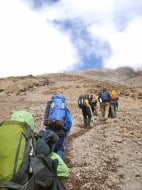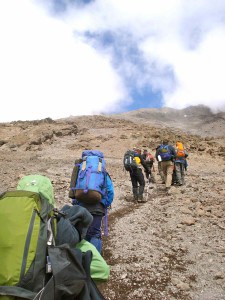
When is the Best Time to Climb Kilimanjaro?
The majestic Mount Kilimanjaro sits on the northern border of Tanzania. It’s well-known as the tallest free-standing mountain in the world, reaching 5,895 meters above sea level.
Due to the mountain’s close proximity to the equator, it does not experience the extremes of winter or summer. This being said, its weather patterns are defined by dry and wet seasons.
Yes, it’s possible to climb Kilimanjaro all-year-round, however, there are seasons where the experience is a little more enjoyable!
If you’re planning the trek of a lifetime up Mount Kilimanjaro, here’s what you should know about its weather patterns and the best time to climb.
The Character of Kilimanjaro Weather
The tallest mountain in Africa is a popular place to be in the drier months, simply due to the fact that climbing risks increase as the weather becomes foul.
But in order to choose the best time of year to climb Kilimanjaro, it’s important to understand how the mountain’s weather patterns work.
The weather on Mount Kilimanjaro is largely influenced by trade winds which whip around and travel up and down the mountain.
The south-east trade winds from the Indian Ocean carry tons of moisture. As such, they bring heavy clouds and condensation during the wet season of March-May.
Typically, the southern slopes of the mountain tend to receive the most amount of rain during this time.
Then there are anti-trade winds which blow at the mountain from the north-east. These winds carry very little moisture but tend to howl through the months of April-October.
These north-east trade winds ensure the moisture-laden south-east winds stay on the lower slopes, making for a drier trekking experience as you ascend.
As such, these winds determine complex weather patterns on the mountain and create two distinct trekking seasons: January-March and June-October.
The Best Months to Climb Kilimanjaro
As we mentioned, it is possible to climb Kilimanjaro all-year-round, but if you are trekking beginner, the wet season is not recommended.
The warmer and drier months mean the mountain is a little more crowded, so it’s important to determine what’s more appealing. Would you prefer colder weather and fewer crowds, or warmer weather and higher foot traffic?
But before you come to your decision, here’s a breakdown of the best months to climb Kilimanjaro:
January to March
If you’re new to hiking and Mount Kilimanjaro is your first major climb, then this is the best time to plan your adventure.
These months are characterized by the warmest weather, clear skies, and less snow on along your hiking trail, though some can be expected at the summit.

The clear air also makes for phenomenal views of the surrounding landscape and neighboring mountains. If you aren’t too keen on crowds, this is also a great time to climb as this is out-of-season for both European and American tourists.
Keep in mind that the evenings are still cold, especially closer to the summit, so warm hiking gear is essential!
June to October
By the end of June the long wet, rainy season is well and truly over, however, you can still expect some cloudiness on the lower slopes.
Once you ascend to higher altitudes, the skies become beautifully clear and the air crisp. The weather is generally a little colder this time of year, although still pleasant.
This is a busier time of year to climb Kilimanjaro due to the fact that it’s summer holidays and in-season for most European countries and the US.
Despite this, the mountain never feels over-crowded due to the huge expanse it covers. You will find no more than two trekking groups at a time along some routes.
This is a great time of year to climb if you are a solo traveler but want to hike the mountain with a group.
The Wet Seasons
Kilimanjaro is host to two major wet seasons. The first runs from mid-March to June and the second, though far shorter, runs from November-December.
If you are a well-seasons trekker and crave complete solitude during your climb, this is the ideal time of year for you. However, climbing in the wet season(s) is generally not recommended.
The colder weather, persistent rain, and wetness, increased risk of slips and falls can take its toll on inexperienced climbers, making for a tough experience.
Your likelihood of actually summiting the mountain is also greatly reduced.
Climbing Kilimanjaro by Moonlight
For a completely unique, magical experience you can also plan your Kilimanjaro summit around the light of a full moon. These treks are very popular, so make sure to book well in advance.
In order to experience the glory of the mountain’s glaciers lit up by moonlight, a typical 7-day trek will begin 5 days before the date of a full moon.
Generally, full moon climbs are arranged once a month by most Kilimanjaro tour operators.
Keep in mind that if you’d prefer a quieter trek and a night sky packed with stars, the full moon trek is perhaps not for you!
Kilimanjaro’s Climate Zones
Kilimanjaro is a unique environment home to four distinct climatic zones, each characterized by their own weather, temperature, and landscape.
These varying climatic zones are likely to make the greatest impact on your climb.
1. The Rainforest Zone
This area of the mountain is characterized by warmer weather and high humidity. Rain is highly common throughout most months of the year and the temperature ranges from 53-62 degrees Fahrenheit.
2. The Low Alpine Zone
The low alpine zone is characterized by semi-arid, alpine forest where temperatures begin to drop. They generally range from 41-50 degrees Fahrenheit. The skies are clearer with little to no rain in this zone.
3. The High Alpine Zone
This is a desert-like landscape, almost like walking on the moon. Temperatures tend to drop down to freezing, averaging around 32 degrees Fahrenheit. Winds can be stronger, adding to the cold factor.
4. The Summit
This is known as a glacial zone as the summit of the mountain. Here you can expect high winds which make the summit feel much colder than it is. Temperatures range from 21 degrees, but can sometimes feel like -4 degrees Fahrenheit.
Conquer Kilimanjaro With African Sermon Safaris
If reaching the summit of Kilimanjaro is your life-long goal, African Sermon Safaris would be happy to make your dream a reality.
We offer three popular routes to climb Kilimanjaro, guided and supported by our experienced, well-trained, and enthusiastic team.
Contact African Sermon Safaris today to book your trek of a lifetime.